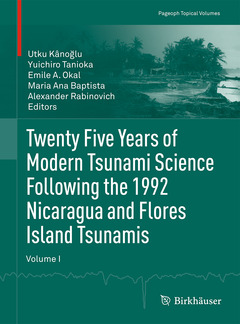Twenty Five Years of Modern Tsunami Science Following the 1992 Nicaragua and Flores Island Tsunamis. Volume I, 1st ed. 2020 Pageoph Topical Volumes Series
Coordonnateurs : Kânoğlu Utku, Tanioka Yuichiro, Okal Emile A., Baptista Maria Ana, Rabinovich Alexander B.

This book is of interest to scientists and practitioners as well postgraduate students in geophysics, oceanography and coastal engineering involved in all aspects of tsunamis, from earthquake source processes to transoceanic wave propagation, from coastal impacts to hazard assessment, combining recent case studies with advances in tsunami science and natural hazards mitigation.
Previously published in Pure and Applied Geophysics, Volume 176, Issue 7, 2019
Utku Kânoğlu is professor at the Department of Aerospace Engineering, Middle East Technical University, Ankara, Turkey. He holds a Ph.D. from the Tsunami Research Center, University of Southern California. He is actively involved with all aspects of tsunami research including numerical, laboratory and field studies, with an emphasis on analytical solutions; leading to forecasting, hazard assessment, and mitigation and planning.
Yuichiro Tanioka is currently professor at the Faculty of Science, Hokkaido University, Japan. He is also a member of earthquake research committees of the Headquarters for Earthquake Research Promotion in Japan. He was director of the Institute of Seismology and Volcanology at Hokkaido University until 2018. He was also a vice-president of the Seismological Society of Japan until 2017. He is interested in research on tsunami generation mechanism, source processes of great earthquakes, and development of tsunami early warning techniques.
Emile A. Okal is professor Emeritus at the Department of Earth & Planetary Sciences at Northwestern University. He is a seismologist with a specialization in tsunamis, and the origin of deep earthquakes. He holds a Ph.D. from the California Institute of Technology.
Maria Ana Baptista is professor at Instituto Politécnico de Lisboa and an invited professor at Universidade de Lisboa. She holds a Ph.D. in Physics - Geophysics of the University of Lisbon. Her research interests are tsunamis and natural hazards. She was the Vice-Chair of the Intergovernmental Coordination Group of IOC UNESCO for the implementation of the Tsunami Early Warning System in the period 2007-2011, and involved actively in the implementation of the Portuguese Tsunami Warning System. She coordinated the FP7 project on tsunamis - ASTARTE (Assessment Strategy and Risk Reduction for Tsunamis in Europe).
Alexander B. Rabinovich, Ph.D., is a research scientist at both the Tsunami Laboratory
Contains up-to-date developments in tsunami science
Combines recent case studies with advances in tsunami science and natural hazards mitigation
Reviews historical tsunami events and field surveys, tsunami source models, landslide generated tsunamis, and tsunami numerical modeling
Overviews the main achievements in tsunami science over the past 25 years
Presents overview articles from the 1992-2018 tsunami events and post-event field surveys
Date de parution : 04-2020
Ouvrage de 519 p.
19.3x26 cm



